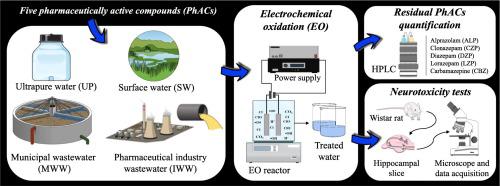Journal of Water Process Engineering ( IF 6.3 ) Pub Date : 2022-07-15 , DOI: 10.1016/j.jwpe.2022.102990 Bianca Miguel de Souza-Chaves , Morgana Bosio , Márcia Dezotti , Maria Emília Quinta-Ferreira , Rosa M. Quinta-Ferreira , Enrico Mendes Saggioro

|
Benzodiazepines and carbamazepine are mental disorder treatment-related contaminants of emerging concern (CECs) routinely detected in water bodies. Electrochemical oxidation (EO) processes have been proven effective in reducing CECs levels, although the toxic effects of residual compounds formed after EO are still scarcely studied. Herein, ultrapure water (UP), surface water (SW), municipal wastewater (MWW), and industrial pharmaceutical wastewater (IWW) were spiked with four benzodiazepines (alprazolam, clonazepam, diazepam, lorazepam) and carbamazepine (100 μg L−1 each) and treated by an EO process employing two electrodes: a platinum-coated titanium (Ti/Pt) and a boron-doped diamond (BDD). Neurotoxicity tests were performed by exposing rat hippocampus slices to EO-treated waters to investigate the effects of residual compounds on neuronal activity. The EO results indicate that both electrodes were efficient in completely removing the studied drugs from UP and SW, but that <50 % removal was achieved for MWW. For IWW, total organic carbon (up to 71 %) and total nitrogen (up to 82 %) removals were achieved at 1000 A m−2. UP exposure significantly reduced ROS production, likely due to the presence of transformation by-products. SW and MWW EO-treated waters led to slight neurotoxicity. Decreased neurotoxicity was mainly observed for the IWW after EO using both the BDD and Ti/Pt anodes. A ROS production evaluation following the application of several untreated effluent cycles demonstrated that long-term effects may alter cell functionality and that recovery responses decrease over time.
中文翻译:

先进的电化学氧化应用于苯二氮卓和卡马西平去除:利用大鼠海马神经元活动的水基质效应和神经毒性评估
苯二氮卓类药物和卡马西平是与精神障碍治疗相关的新兴关注污染物 (CEC),通常在水体中检测到。电化学氧化 (EO) 工艺已被证明可有效降低 CEC 水平,尽管仍然很少研究 EO 后形成的残留化合物的毒性作用。在此,超纯水 (UP)、地表水 (SW)、市政废水 (MWW) 和工业制药废水 (IWW) 中加入了四种苯二氮卓类药物(阿普唑仑、氯硝西泮、地西泮、劳拉西泮)和卡马西平(100 μg L -1每个)并通过使用两个电极的 EO 工艺进行处理:铂涂层钛 (Ti/Pt) 和硼掺杂金刚石 (BDD)。通过将大鼠海马切片暴露于 EO 处理的水进行神经毒性测试,以研究残留化合物对神经元活动的影响。EO 结果表明,两个电极都能有效地从 UP 和 SW 中完全去除所研究的药物,但 MWW 的去除率 <50%。对于 IWW,在 1000 A m -2时实现了总有机碳(高达 71 %)和总氮(高达 82 %)的去除. UP 暴露显着降低了 ROS 的产生,可能是由于存在转化副产物。SW 和 MWW EO 处理的水导致轻微的神经毒性。在使用 BDD 和 Ti/Pt 阳极进行 EO 后,IWW 的神经毒性主要被观察到。应用几个未经处理的流出物循环后的 ROS 产生评估表明,长期影响可能会改变细胞功能,并且恢复响应会随着时间的推移而降低。











































 京公网安备 11010802027423号
京公网安备 11010802027423号